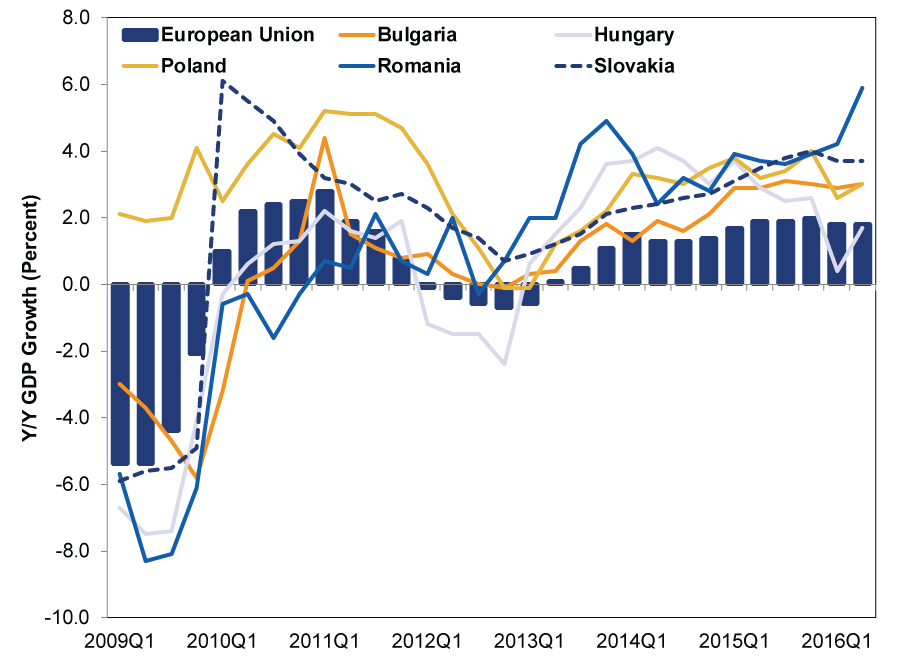Personal Wealth Management / Market Analysis
Around the World in Lots of Data
Little-noticed developing economies are contributing nicely to global growth.
Discussion of the developing world often focuses on the big economies, playing up their challenges, real and perceived. Today, that means China's slowing growth and occasional debt worries, plus the damaging effects of low energy prices on oil-exporting countries like Brazil and Russia. This focus is understandable, but the media fixation may cause you to miss the broader picture. In that light, we present a roundup of recent growth reports you may have missed.[i] While challenges exist, on balance, the developing world's economic health is better than widely appreciated-and continues supporting global growth. Heck, even Greece grew! And beyond those nations pining for the days of triple-digit oil prices, the outlook is broadly positive.
Let's begin in Europe. The European Union's growth slightly slowed in Q2, (0.4% q/q versus Q1's 0.5%), but developing EU nations grew quicker. Frontier Markets Romania and Bulgaria, Slovakia, and Emerging Markets Poland and Hungary clustered at the top of Q2 growth rates, with 21 of 28 countries reporting so far. On balance, these five nations accelerated in Q2-with two flipping from slight contraction to expansion. After plunging furthest following the financial crisis, Eastern Europe's yearly growth rates have mostly surpassed the EU as a whole.
Exhibit 1: Eastern Europe Leads EU Growth
Source: Eurostat, as of 8/23/2016. Real eurozone GDP (seasonally adjusted), Q1 2009 - Q2 2016.
Here's a look at what drove the most recent quarterly numbers:
- Romania led the way, expanding a rapid 1.5% q/q. Tax cuts and wage increases boosted consumption as election-year stimulus took effect.
- In Bulgaria, GDP grew 0.7% q/q. Consumption and fixed capital rose slightly while net exports detracted, as exports fell and imports rose. However, rising imports are good news-they represent rising domestic demand.
- Hungarian growth bounced back from a -0.7% quarterly drop in Q1 to a 1.1% gain in Q2. Services, industrial output and agriculture led the way.
- On to Slovakia, which grew 0.9% q/q, surprising forecasters. Car sales (particularly exports) contributed nicely, while rising employment and wages goosed consumption.
- Lastly, Poland, also at 0.9% growth q/q, was the only of these five to lag forecasts. But 3.0% yearly expansion is nothing to sneeze at, and it is up from Q1's 2.6%. Details aren't available in this early release, but monthly data suggest trade, industrial output and retail sales supported growth.
In all five countries, construction and investment detracted in Q2, as a year-end 2015 deadline to use up EU aid money pulled spending forward. Nevertheless, all are growing. Oil's affordability helped: The five are importers-Hungarian and Bulgarian net energy imports accounted for 6% of GDP in 2014, when oil prices began to slide. Cheaper energy keeps inflation in check and sends real income higher. Consumers and businesses may save, spend or pay down debt with the windfall, but in any case they come out ahead.
The story is much the same in Emerging Asia:
- South Korean growth beat expectations in Q2, rising 0.7% q/q (3.2% y/y), the fastest rate since Q3 2014. Temporary tax breaks on cars and appliances helped boost consumption (3.2% q/q), while low interest rates fueled construction and fixed investment (5.1% q/q). Trade detracted from GDP, as imports exceeded exports, but both grew, and total trade-exports plus imports-is more economically meaningful than net. (See Bulgaria for details.)
- Thailand also grew more than anticipated in Q2 (0.8% m/m, 3.5% y/y), led by private consumption.
- Indonesia grew 4.0% in Q2 (5.2% y/y), thanks to more government and household spending alongside higher commodity prices. Commodity prices are still comparatively depressed-but while Indonesia is a commodity exporter, it is not commodity-reliant. It also has a strong and growing services sector.
- The Philippines grew 1.8% q/q in Q2, putting year-over-year growth at a whopping 7.0%. Investment contributed most (27.6% y/y) and consumption second-most (7.3% y/y). While trade detracted, this was due to an astounding 39% y/y growth in imports in May, driven by equipment and raw materials.[ii]
- Malaysian growth slowed as most anticipated, but stayed well into positive territory at 0.7% q/q, 4.0% y/y.
In Latin America, home to more commodity-heavy economies than Asia or Europe, recent data were more mixed. Colombia has yet to report, while the other three Latin American EMs drifted a bit. Chile grew 1.5% y/y-beating 1.2% estimates, but slowing from Q1's 2.2%.[iii] Peru slowed from 4.4% y/y to a still-respectable 3.7%, with the slowdown underpinned by disruptions in Energy production.[iv] Mexico contracted slightly quarter-over-quarter, with Energy and Mining's well-known issues a primary culprit.[v] The trend, however, is growth: On a yearly basis, Mexican GDP grew 2.5%.
Now, individually, none of these nations are exactly huge economies. But combined they're a solid slice of world GDP-about 7.8%, according to 2015 World Bank figures. That would be the world's third-biggest economy, topping Japan, Germany and the UK. Together with positive growth in most other larger nations, they help form a backdrop of underappreciated global growth that supports rising stocks.
[i] As we're pretty sure you did, unless you make a habit of carefully tracking economic trends in the likes of Slovakia and Peru.
If you would like to contact the editors responsible for this article, please message MarketMinder directly.
*The content contained in this article represents only the opinions and viewpoints of the Fisher Investments editorial staff.
Get a weekly roundup of our market insights
Sign up for our weekly e-mail newsletter.

You Imagine Your Future. We Help You Get There.
Are you ready to start your journey to a better financial future?

Where Might the Market Go Next?
Confidently tackle the market’s ups and downs with independent research and analysis that tells you where we think stocks are headed—and why.





